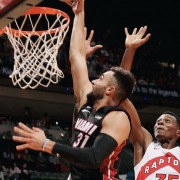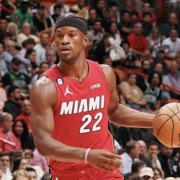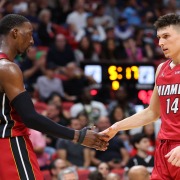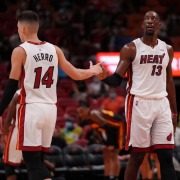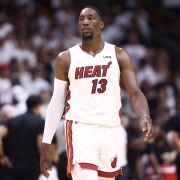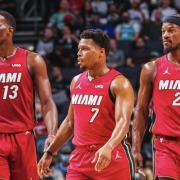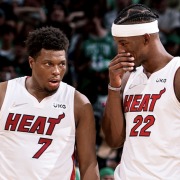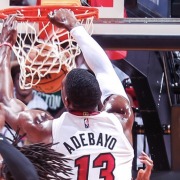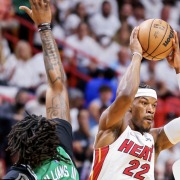Looking back over this season for the Miami Heat, they finished as the first seed in the Eastern Conference, yet capped out in the Eastern Conference Finals in game 7, one win, or one shot, away from another NBA Finals appearance.
So, now that it’s officially off-season time, it’s time to project forward. But you can’t fully look ahead until you evaluate the past, so let’s take a brief look throughout the roster to establish both what happened and what’s next…
Jimmy Butler:
What happened?
When talking about the Miami Heat, you must start out with the headliner, which is clearly Jimmy Butler. Sometimes a season is remembered by how you start, and other times by how you finish. And in Butler’s case, he capitalized in both of those fields.
From MVP ladder rankings to begin the year to a 47 point masterpiece in game 6 of the Eastern Conference Finals facing elimination, it’s no doubt that it was a terrific season. We all know about his defensive excellence when surrounded by strong defenders, but carrying the offensive load yet again to this degree was eye opening.
Y’all can have fun with NBA player rankings, but Butler cemented himself as a clear top 10 player in today’s league.
What’s next?
When talking about the next steps for individual players, I’m going to do a lot of talking about simple on-court improvements or the next stage of a contract/trade possibility. Yet for Jimmy Butler, it’s about just the opposite.
It’s just building a roster to get him that ring that he so very deserves, which was one of the primary reasons he landed in Miami in the first place. Watching him put it all out there in this post-season showed one thing that we probably already knew: build fully around Butler to get this group over the hump. Basically the playoff motto for the Heat in this recent run: get Jimmy Butler some help.
Bam Adebayo:
What happened?
Offensively he may have his ups and downs on picking when to go and be aggressive, but his impact was felt from game 1 to game 100. One of the league’s best defenders, even if the voters couldn’t recognize that. Games 3 and 7 of the Eastern Conference Finals showed flashes again on the other end, mostly about the hope of what he would look like as a full-time third option on the offensive end.
In the mix of things throughout the season, Adebayo receives a lot of blame from the public. When they lose, it’s easy to look over at his stat-line and make that the reason it occurred, but it truly isn’t the full story. There’s no doubt the aggression will have to pick up in a more consistent manner, but Adebayo did his job this season, and that game 7 proved the focal points of this Heat group.
What’s Next?
Clearly Adebayo is locked into contract and isn’t going anywhere, so what’s next for him is much more game-based. His defensive traits are here to stay, meaning the offense will always be the primary focus in an off-season.
When players talk about that specific focus, it’s usually prefaced by “perfecting my all-around game.” But when it comes to Adebayo, I don’t believe that to be the case.
The next step for him: a go-to offensive move that we’ve discussed for quite some time. Is it a post-up move? Face-ups? Jumper? It’s tough to say, but it comes down to his comfort level in certain spots.
Something to watch for though: Bam Adebayo loves that baseline. No matter if he’s in position for a post-up or a face-up, the end result is most likely going to be a baseline dash or a post spin down that line for position under the rim. So I’m thinking they’re going to find a way to maximize his skill down there.
Tyler Herro:
What happened?
As I stated earlier, the way you finish a season is usually remembered much more than the main chunk of your production in a certain time frame. And for Tyler Herro, he wasn’t even lucky enough to actually “finish” his season correctly after dealing with that groin injury in the Eastern Conference Finals.
But to zoom out a bit, he grew a ton this past season as an offensive player. Aside from winning the sixth man of the year award, he was right up there at the top of the scoring list with Butler in the regular season.
But it isn’t about the numbers, he grew as a creator in terms of finding healthy step-backs and fade-aways to get his shot off against good defenses. He even grew to the degree that teams through the entire playoffs threw different defensive coverages at him since they were so worried about him. Those obstacles slowed him down a good amount, but there’s no doubt he made strides this year as a scorer in this league.
What’s next?
When hearing what is next for Tyler Herro at this time of year, I know what you all are thinking. Donovan Mitchell. Zach LaVine. Damian Lillard. Probably even LeBron James or Giannis Antetokounmpo. The point is that he’s going to be thrown into any conversation for those stars to improve the team, and I mean rightfully so. Everybody is pulling that trigger to land a star in this league next to Jimmy Butler and Bam Adebayo.
But the realistic element: it’s not that likely. Yes top players always move around every off-season, but this is totally out of the Heat’s control. It’s 1) on the specific player to ask out and demand Miami and 2) the opposing team has to actually like the trade package you’re offering.
Aside from all of those fantasies, there are clear areas for him to improve on the basketball court. The first step is his driving game, which did make strides throughout the regular season, but the physicality of the playoffs blocked the rim off for him to attack.
He must find ways to draw contact on those stop signs standing in the lane, which may develop with his focus on adding some extra upper body strength.
The last thing is a combination of a live dribble and his play-making skills. That’s another thing that was peaking late in the regular season, but the constant blitzing and doubles he faced found ways to stall out both him and the team’s offense. Working on those quicker passing triggers will be key for his off-season development.
Oh, and the last thing to note, the next step for him personally is becoming a full-time Heat starter.
Kyle Lowry:
What happened?
I feel like the Kyle Lowry section is one of the hardest to sum up into words. He had a strong regular season in terms of carrying the team when guys went down, which was pretty much what the Heat needed when they acquired him.
But the other thing they needed was the two words he used pretty often in the regular season: “real season.” His ramp up process was hitting new levels late in the regular season, which Erik Spoelstra joked recently that they wished the playoffs could’ve started then. But well, they didn’t.
Lowry started off the “real season” pretty well with some strong performances at the beginning of the Hawks series, but the fall-off came a little after as injuries struck. In and out was his story-line the rest of the way, as that hamstring never truly allowed him to look right. He had a big game 6 in the ECF next to Jimmy Butler, but it capped off there.
I feel like he exceeded some of the regular season expectations with the hot pockets throughout the year when guys went down, but the playoffs plummeted quite a bit. Was it simply derailed by injuries? Was that usual burst to the rim and pull-up shooting gone? I’m not sure, but I do know that hamstring situation didn’t help.
What’s next?
Kyle Lowry is locked into a decent sized contract with this Heat team moving forward, meaning “what’s next” seems to be characterized by a potential trade for some. But let me just say this in simple terms: Kyle Lowry came to the Heat because of Jimmy Butler. Kyle Lowry and Jimmy Butler are close friends. Jimmy Butler isn’t allowing Kyle Lowry to be traded.
Maybe that last sentence has an exception if it’s grabbing a top tier star and he needs to be packaged, but even then it gets a bit cloudy. The point is that Lowry is a part of this current build, so the focus on what is next is how to maximize him.
And this isn’t young player development like improving on a specific skill, this is honing in on his body and physical build. Something Spoelstra danced around in his exit interview presser was the idea of Lowry getting into Heat shape, finishing the convo off with “I think Kyle will come back next training camp in the best shape of his career.”
That fixes a lot of what we’re discussing. He needs to be in great shape, preserve himself in the regular season, and be fresh by the time the playoffs roll around. That’s what Butler did this past year, and that’s what Lowry will need to do.
PJ Tucker:
What happened?
PJ Tucker simply exceeded all expectations in everybody’s eyes from the front office to teammates to fans. We knew he was a defensive dawg, but increasing the offensive display of a 37 year old isn’t easy. Speolstra talked about how he was surprised of this ascension, as he even carried the load of the front-court when Bam went down with injury for a month and a half.
Tucker told Spo that he used to play some point guard, and he didn’t believe him. When he reassured, Spo tweaked the December game-plan of giving Tucker some more play-making reps, which included a hot stretch of running some post-spits and different sets for him for a good chunk of time.
We also can’t just say he was great defensively while not punching that point home. He made Trae Young’s life horrible in the first round, handled both James Harden and Joel Embiid off switches all series long, and didn’t allow Jayson Tatum maximum comfort all 7 games. He was the rock of everything they did, and every Heat player has made sure to point that out all year.
What’s next?
Contract wise for Tucker, he’s one of those flexible off-season pieces to watch as he has that $7.4 million player option at the moment. I’m not the guy to fully project forward on what he will do with that, but it’s clear no matter if he opts in or out, the Heat will be very focused on bringing him back.
Yet as he isn’t getting any younger, the enticing part about his return would be making his life a bit easier with some type of front-court addition. More than anything though, he just wants to be out there and play, and it’s clear he fits Pat Riley, Erik Spoelstra, Jimmy Butler, and this organization to an absolute T.
Duncan Robinson:
What happened?
As Tucker may have exceed many expectations, it’s pretty clear that nobody saw the Robinson season coming at all. After receiving his healthy bag, he endured some shooting struggles to begin the year.
Spoelstra and the Heat stuck with him all the way through, yet he could never really find his usual comfort and consistency from deep, while it felt like the offense was being restricted at times to get him going.
One Jimmy Butler and Erik Spoelstra fight and a 4 game losing streak later, a change was made. The Heat shifted the starting lineup and rotation to have Max Strus start at the 2, trying to find a spark in anyway possible. And that was exactly found.
Robinson then began to trickle down the Heat’s rotation little by little, eventually finding himself on the outside looking in by playoff time.
What’s next?
The next stage for Robinson is unclear, but the next stage for the Heat with Robinson is a bit clearer. As I pointed out earlier, yes, he’d be included in the big time deals for the star-powered players in Heat jersey swaps on social media. But the Heat’s off-season isn’t going to consist of waiting around for something that probably won’t even happen.
So, could a Robinson deal be done on its own to patch up some holes in the roster? Very much so. Talking about Tucker possibly needing some front-court help on the surface, the question becomes: who could Robinson get you as a potential stretch big?
We have a full off-season to talk about that now, but the point is that’s the next outlet for Robinson and the Heat. There are clearly teams that can use the shooting gift that Robinson possesses, and the Heat may need to shift in another direction.
Gabe Vincent:
What happened?
Entering this season, there was one hole on the Heat’s roster according to many Heat observers: back-up point guard. Gabe Vincent was going to be a fine third string point guard, but they needed a trusted back-up.
Not only did Vincent emerge into that, he progressed into a solid starting point guard for many slots of the regular season and the playoffs.
Not enough is said about the strides he made in his all-around game. Many were eyeing his shooting from deep since that’s what landed him on the roster in the first place, and that began to click as well. But more importantly, he became a big time defender, his play-making skills grew more than expected, and they transitioned him from a small 2 into a solid 1. In terms of production and progression, Vincent was one of the true success stories from this year.
What’s next?
Some may call Vincent or Max Strus sweeteners for a potential star-powered trade, but I don’t think it gets much sweeter than two highly productive rotation players on minimum contracts next season. That is just incredible value from a contractual perspective.
On the other side of things, I truly believe Vincent’s off-season development approach will be the cliche “improving in all areas.” It’s working on the consistency of the outside shot, the effectiveness of the pull-up, a tighter handle, and most importantly, quick play-making attributes.
Max Strus:
What happened?
As illustrated in other areas of this piece, Max Strus emerged this season from out of nowhere. Sometimes it’s not about fully jumping onto the scene, but just arriving at the right time. As much as we group Vincent, Strus, and Caleb Martin together in that young undrafted branch, many Heat observers compared them often.
Why is that? Well, there were only so many rotation spots, so the question continued to be ‘who was going to be the odd man out?’ For a good stretch of time with Vincent and Martin’s offensive game surging, that guy seemed to be Strus. But well, you know how that story ended up going.
Robinson struggled, changes were made, and Strus found himself in the starting lineup on the biggest stages. In the same breath as Vincent, he was a major success story for this Heat developmental staff who just continues to do it again and again.
What’s next?
Not to be too repetitive, but as described previously with Vincent, his contract is just an insane amount of value heading into this next season. But as much as that’s a thing, they’re going to be playing for even bigger pay-days next season heading into free agency.
For Strus individually, the shooting is clearly his staple. He had some flashes of strong attacks and defensive stops, but those will need to improve heading into this next season.
But since he’s going to be a part of this Heat offense yet again, he’s going to need something out of Duncan Robinson’s book from previous years: effectiveness off dribble hand-offs.
Strus is a tough shot maker and a clear movement shooter, but a lot of his shooting stretches came off slip screens or ghost screens into a spot-up jumper on the wing. Or just the usual catch and shoot from anywhere on the floor. But the smoothness of a Robinson hand-off would be crucial for Strus as the “best shooter on the team,” as he proclaimed with semi-air quotes.
I can say that he works on it a ton in practice after watching a ton of his post-practice shooting drills this season, but that’ll be a primary focus in the Summer.
Victor Oladipo:
What happened?
Victor Oladipo’s season consisted of an incredible comeback story and extremely small sample sizes. He made his return late in the season showcasing some high level defensive moments, yet the offensive insertion slowed down the Heat’s strides late in the year.
They shelved him for some time for that very reason, but when Lowry went down in the playoffs, his number was called again, and he answered the call. He did a very good job as a shot creator when they needed him to be, and a second half against Jaylen Brown and the Celtics in game 1 will be on his career highlight tape.
We know he’s a high-level talent, but the question was how he’d round into shape. He did a good job responding to that, but now the attention turns to what the title of his next chapter will be…
What’s next?
Oladipo is currently a free agent at the moment after he took a chance with the Heat earning the minimum, but now it’s about what his market looks like. The Heat do hold his Bird Rights, so they will have some level of control, but it’s much more on the rest of the league.
Personally, it feels like there’s a good chance he finds his way back onto this Heat roster, which quickly transitions into what is next in his production.
As much as I’ve highlighted individual improvements for much of the Heat’s roster, it’s more about role for Oladipo. Trying to blend him into their game-plan on the fly this season wasn’t the easiest thing to do, since a lot of his play was either standing in the corner as an off-ball threat or going isolation mode.
Once the Heat find out his plans in free agency, they’re going to jump on that pretty quickly. Dissecting what his job on the offensive end will be for this team, so the outline is totally understood by opening night.
Caleb Martin:
What happened?
I feel like I could just copy and paste the story-line of many of these undrafted players who climb up the ladder, since Caleb Martin falls right under that category as well.
Betting on himself by signing a two-way contract with the Heat after being cut by the Charlotte Hornets, then turned into a key rotation player who finished the season on a regular contract with Miami.
A big time game early in the year against the Milwaukee Bucks showed his abilities under the bright lights with so many guys out, but one major defensive run around January capitalized on his effectiveness. A point guard clamping tour from Steph Curry to Chris Paul to De’Aaron Fox to Fred VanVleet. The way he was able to size down proved to be very helpful, and he just fit the build of this team.
What’s next?
Martin is also a free agent, but they will throw him the qualifying offer as Miami can match outside offers if necessary. But after Martin spoke in the exit interviews on Tuesday, he voiced over and over again that he wants to come back to Miami.
So, to continue on what’s next for him personally, I’d like to retreat back to a point I made about Oladipo. When I asked Martin about his focus in improvements and role next season, he kept bringing up one guy’s name: PJ Tucker. The focus won’t be on an individual attribute, even though he noted his shooting consistency will be big, but instead his role is going to be laid out on the table from day one.
Screening, rolling, play-making off the slip. Martin wants to be that dirty work guy that can be relied on regularly much like Tucker has been this past season. This team had a lot of depth this past year, but now they need assigned roles to that depth. And Martin accepting that type of stuff can do just that.
 Loading...
Loading...Dewayne Dedmon/Omer Yurtseven
What happened?
Yes, I’m going to merge two very different players who only share the same position, since both of them are in two totally different spots.
Dewayne Dedmon is coming off a year as the team’s trusted back-up big, while Omer Yurtseven was in an evaluating state as the third string big, who popped into the lineup when needed during Adebayo’s absence.
Dedmon had a strong showing early on, but the minutes declined rapidly in the playoffs as his production slowed down. Spoelstra began going smaller, which is always his most comfortable area, leaving Dedmon on the outside looking in.
Yurtseven, on the other hand, was a garbage time killer. I don’t mean that in a bad way, but his biggest moments came when he’d enter with 3 minutes left and come away with like 6 rebounds out of nowhere. That’s definitely a skill, and he has a good amount of skill while being very young,
What’s next?
The reason I grouped them together was much more about this section. Dewayne Dedmon will be a free agent with the Heat holding Bird Rights, but it pretty much feels like Miami got everything out of him that they needed. The next stage for him in terms of contract could be the end with his Heat tenure.
Omer Yurtseven on the other hand could have a bit more responsibilities. I still believe that the Heat grab some extra front-court pieces either in a possible Robinson trade, or low level free agency options, but Yurtseven will have a fighting chance.
He will have another run in Heat Summer league, now as more of the focal point after Strus dominated the last time around. He’s been working majorly behind the scenes with the coaching staff, so I’m interested to see the way he’s grown by the time Summer league actually starts.
Either way, the back-up big slot feels to be the one area of speculation to kick off this off-season.
Markieff Morris/Udonis Haslem/Haywood Highsmith/Javonte Smart/Mychal Mulder
What happened?
Lastly, we can’t leave anybody off. Markieff Morris had some moments to begin the year, but one Nikola Jokic shove in the back basically ended his role on this Heat team, since his time of recovery kept being extended.
Guys like Haywood Highsmith, Javonte Smart, and Mychal Mulder didn’t really have any major impact on this Heat group, but they’re always important to keep an eye on in this Heat organization.
One moment they’re just some guys in Summer League, and the next thing you know they’re starting 12 games in the regular season. More than anything, the developmental group deserves all of the credit.
What’s next?
Morris will be a free agent as well after earning the minimum, so it feels like it could be the end of the road there, unless no other reserve 4’s come available in free agency. (I’m eyeing Thaddeus Young possibly.)
Haslem just never seems to be done, as his exit interview every year seems to go the same way. He said he will think it over in the off-season, which will probably mean he will be back breaking up bench altercations again next year.
And as I said before, Highsmith, Smart, and Mulder will have some chances in Summer League to show what they’ve got.
(Yes, that’s everybody on the current roster. No, I won’t be addressing the Kyle Guy’s and Mario Chalmer’s from earlier 10-days.)
For business window graphics, interior office signage, custom flags, custom banners and sign repair, reach out to SignsBrowardFortLauderdale
